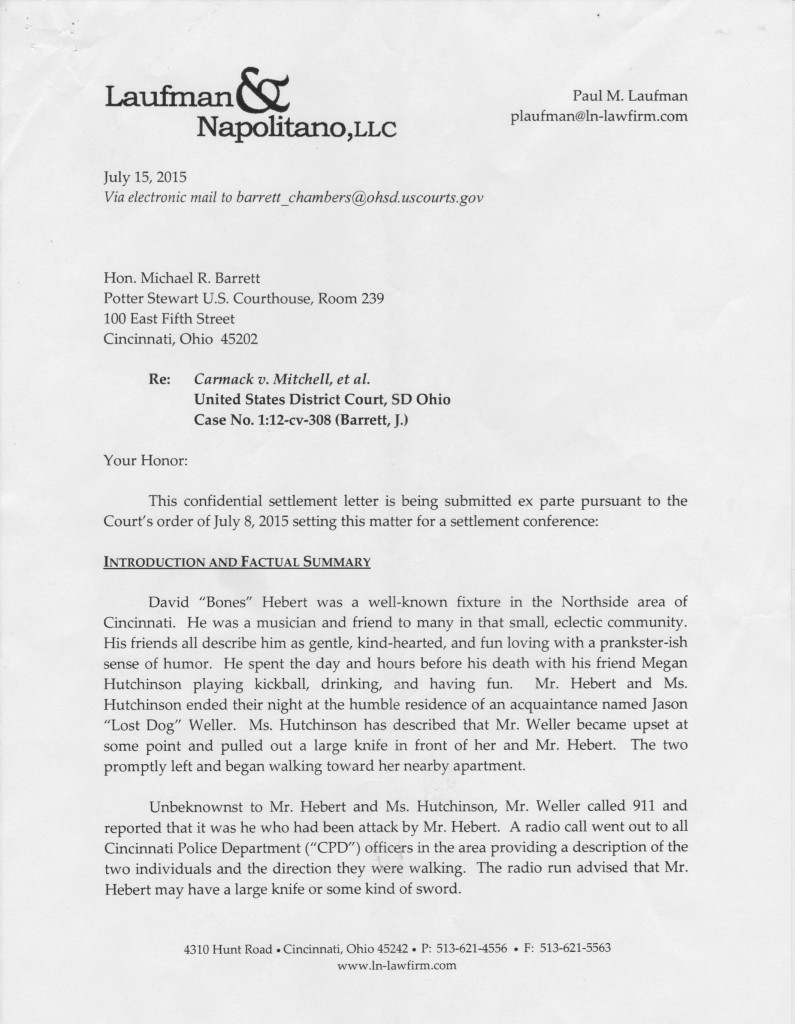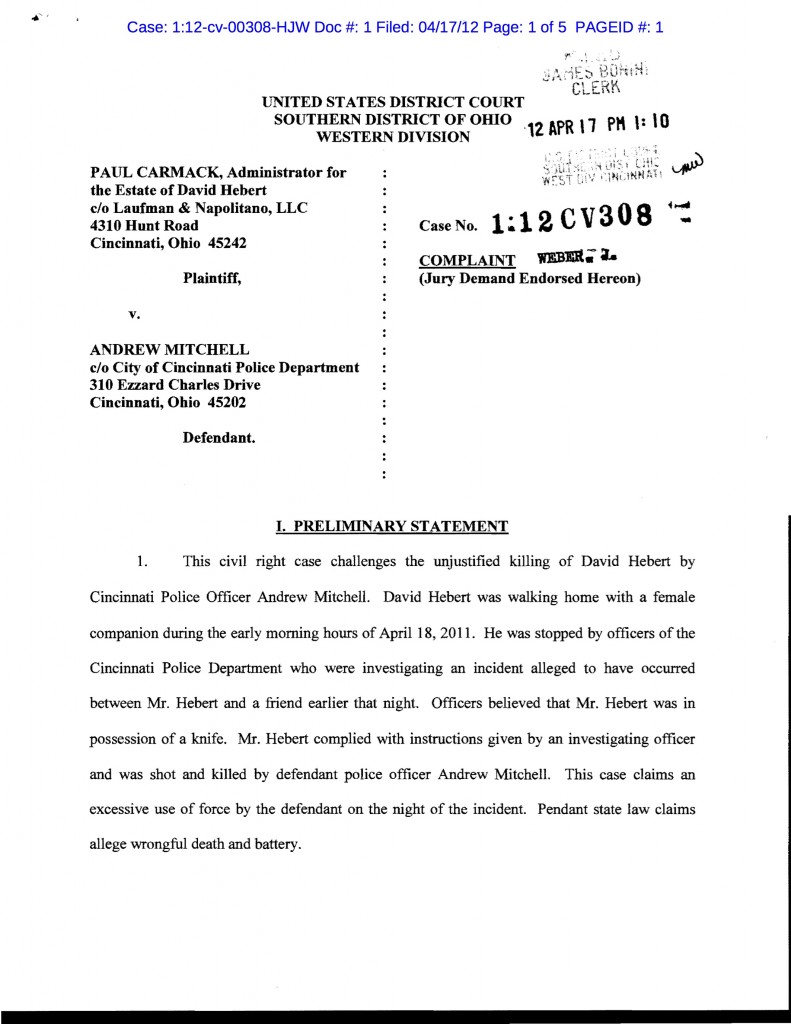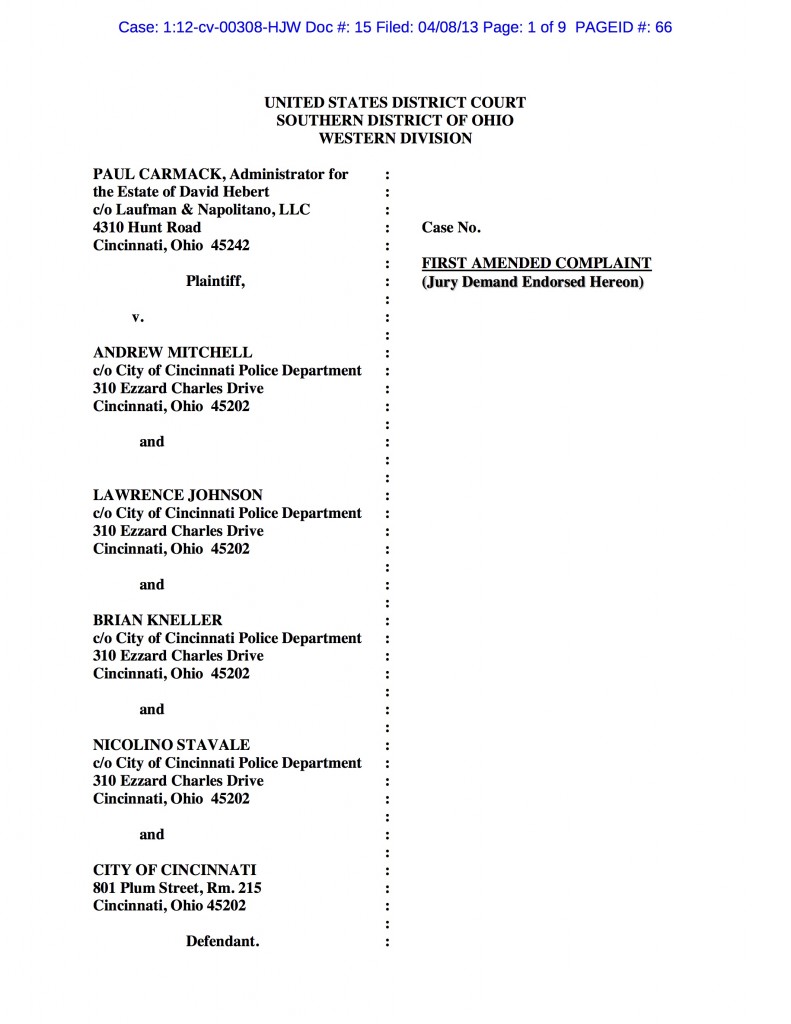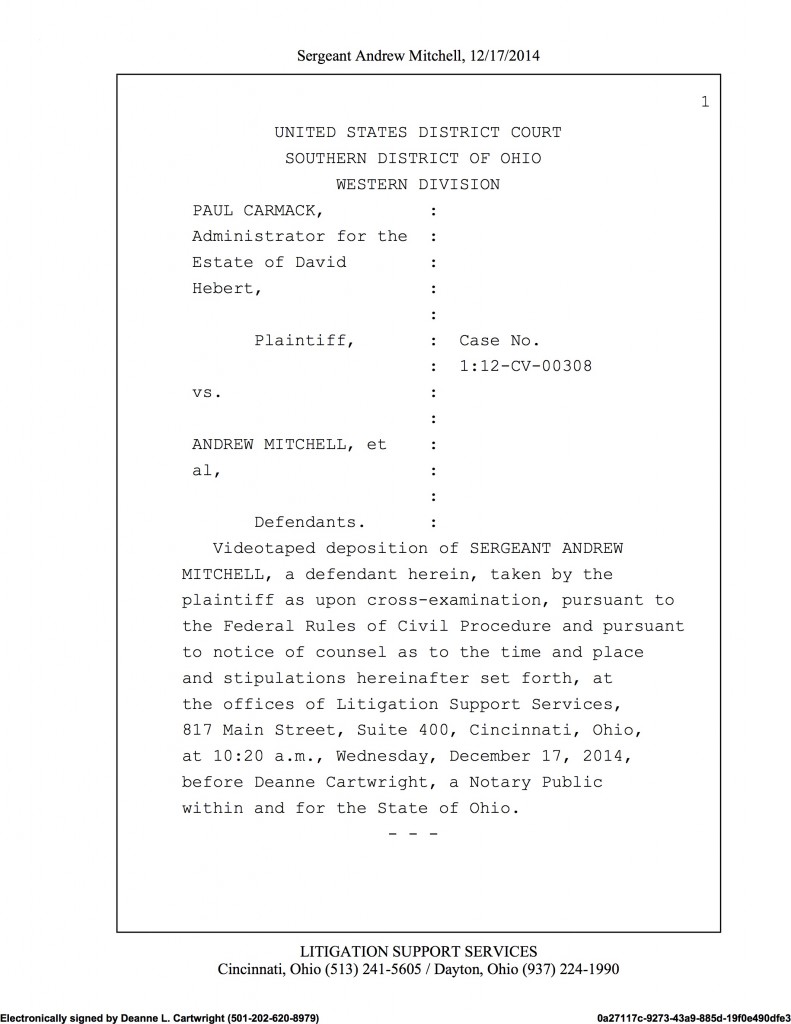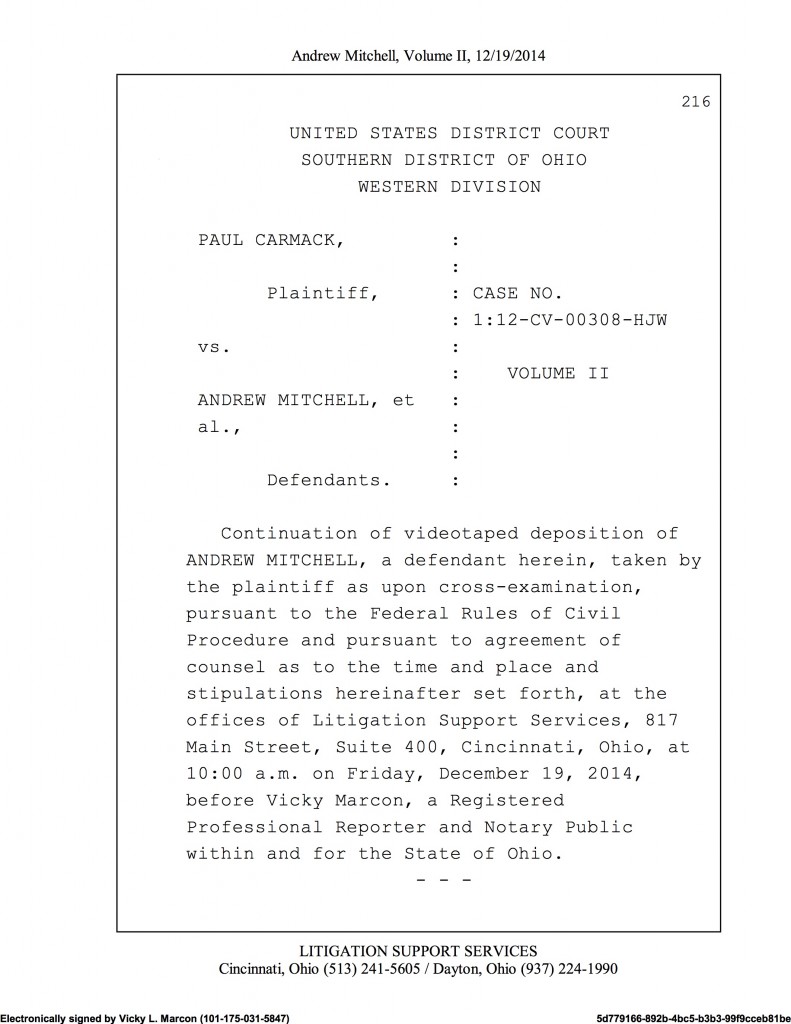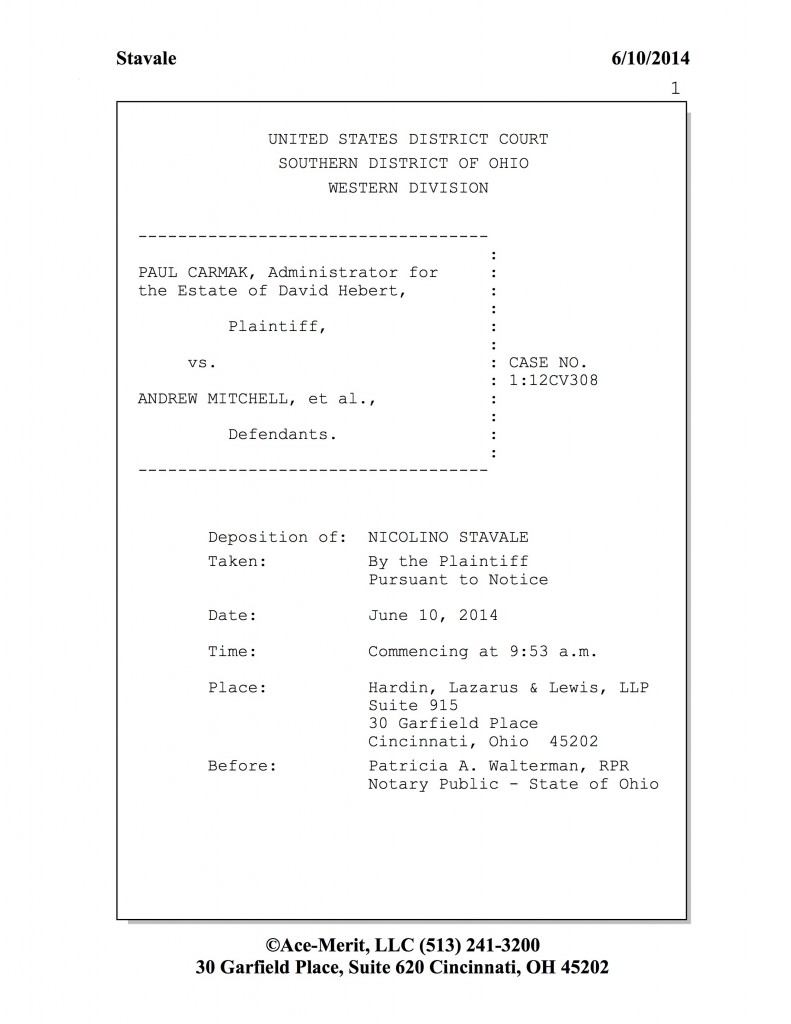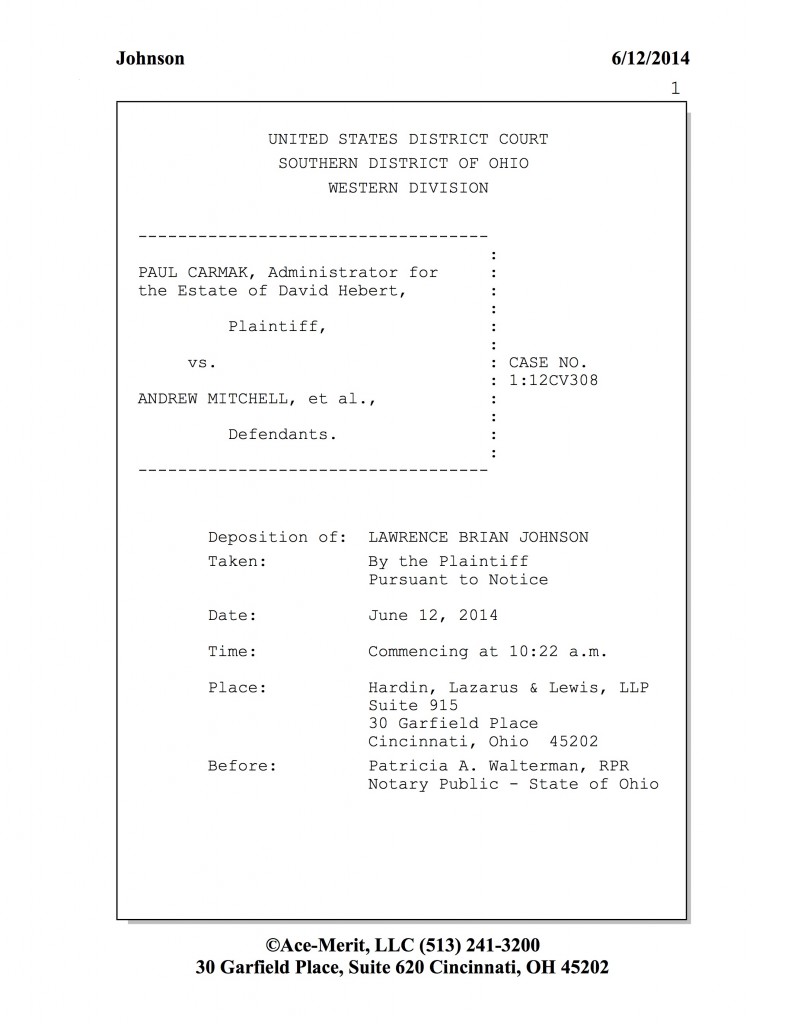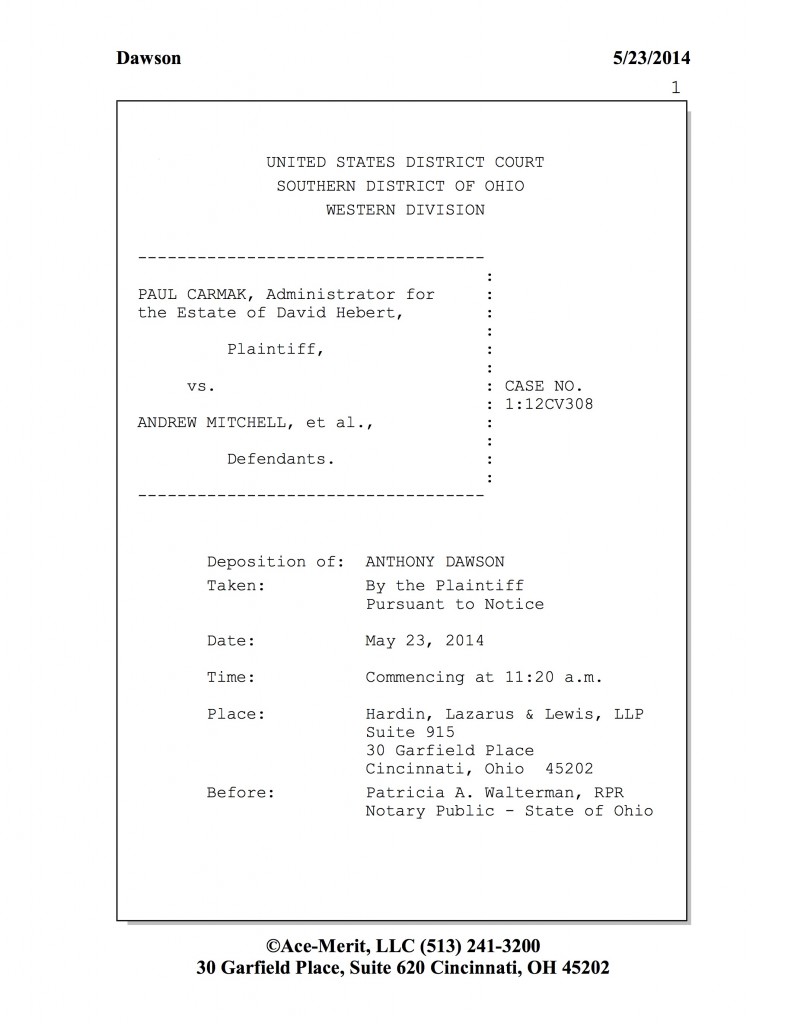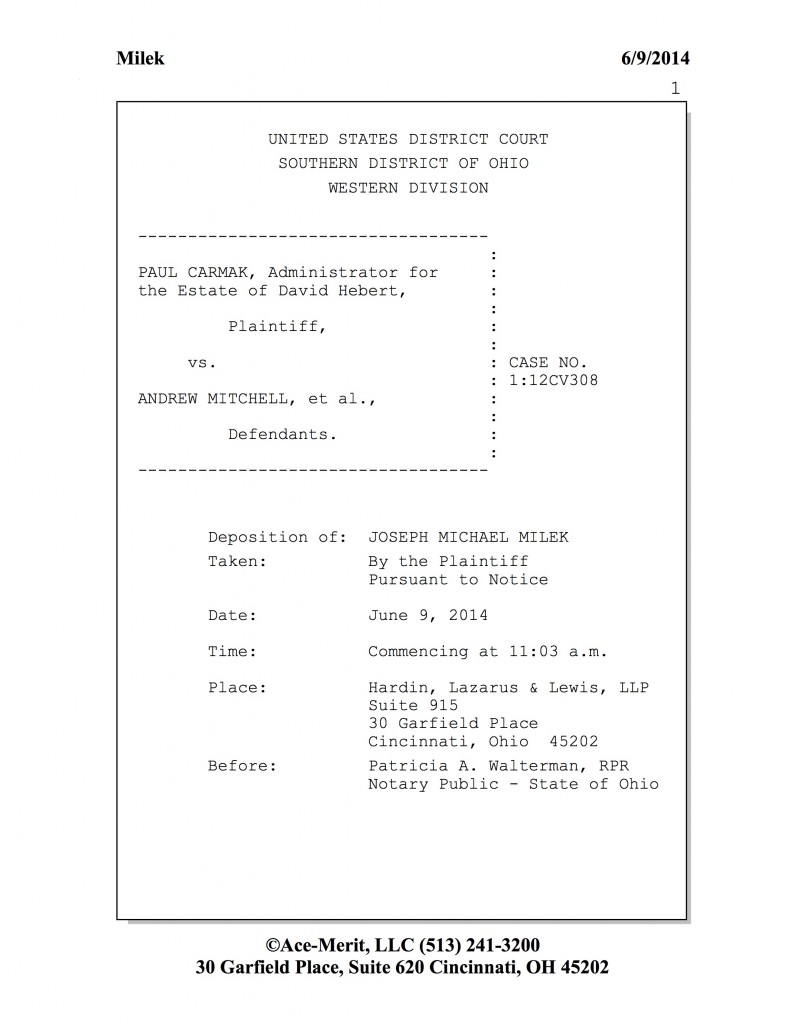Civil Suit
Settlement
Statement of the David Paul Hebert Estate
Today’s statement of clarification issued by the city on behalf of all parties involved concludes a four plus year journey for the truth. This statement clears Bones in the attacking of any officer as well as accepts responsibility for the poor tactics and bad judgment by the officers involved on that night.
We hope the City and CPD review this case and use it as an example of how it can improve its performance and live up to the collaborative agreement set forth by the city after the 2001 riots. This case, along with recent events, have proven that Cincinnati has a long way to go before they should be held up as a national example of good policing. If nothing else, these cases prove that body cameras should be implemented by CPD immediately.
The family and estate are satisfied that this matter has been brought to a close and the truth has been admitted: Wrong place, wrong time, wrong cops.
Again, The Hebert’s and I would like to thank everyone for their support during this journey for the truth. Now the family, as well as everyone who loved Bones, can move forward and begin to heal.
-Paul H Carmack
City of Cincinnati Statement of Clarification and Condolence
“On July 30, the City of Cincinnati, four of its police officers and the Estate of David ‘Bones’ Hebert agreed to settle the civil rights action pending in federal court. Initial reports issued regarding the incident in 2011 declared that Mr. Hebert attacked a police officer with an opened knife or sword.
There was no sword. Furthermore, while an opened knife was recovered at the scene, the evidence that Mr. Hebert intended to attack or swipe at a police officer was not conclusive. Instead, Mr. Hebert’s actions as well as actions taken by the officers on scene contributed to the use of deadly force.
The City regrets this unfortunate loss of life and again expresses its condolences to the family and those who cared for Mr. Hebert. This lawsuit, and now its resolution, should provide confidence that the matter was fully investigated and that a fair resolution was reached to this tragic event.”
Settlement Mediation Statement by Hebert Estate
INTRODUCTION AND FACTUAL SUMMARY
David “Bones” Hebert was a well-known fixture in the Northside area of Cincinnati. He was a musician and friend to many in that small, eclectic community. His friends all describe him as gentle, kind-hearted, and fun loving with a pranksterish sense of humor. He spent the day and hours before his death with his friend Megan Hutchinson playing kickball, drinking, and having fun. Mr. Hebert and Ms. Hutchinson ended their night at the humble residence of an acquaintance named Jason “Lost Dog” Weller. Ms. Hutchinson has described that Mr. Weller became upset at some point and pulled out a large knife in front of her and Mr. Hebert. The two promptly left and began walking toward her nearby apartment.
Unbeknownst to Mr. Hebert and Ms. Hutchinson, Mr. Weller called 911 and reported that it was he who had been attack by Mr. Hebert. A radio call went out to all Cincinnati Police Department (“CPD”) officers in the area providing a description of the two individuals and the direction they were walking. The radio run advised that Mr. Hebert may have a large knife or some kind of sword.
Officer Brian Kneller was the first to locate Mr. Hebert and Ms. Hutchinson. They were both sitting on the sidewalk of Chase Avenue with Mr. Hebert’s dog who had accompanied them that night. Mr. Hebert was sitting with his legs outstretched in front of him, rolling a cigarette with a 40 ounce bottle of beer at his side. Toxicology reports would later reveal that Mr. Hebert had a BAC of .33%. It is safe to say that Mr. Hebert presented no risk of harm to anyone at that point. And that is precisely what Mr. Kneller ascertained when he approached and engaged Mr. Hebert in conversation.
All was proceeding without incident until Officer Larry Johnson arrived. Mr. Johnson intervened in the investigation which Mr. Kneller was conducting and without further inquiry instructed Mr. Herbert to stand up. The CPD’s own firearm review panel took Mr. Johnson to task for multiple tactical errors in his handling of the situation. Mr. Johnson then commanded that Mr. Hebert walk toward him and demanded to know where the knife was. Officers Nicolino Stavale and Andrew Mitchell were arriving as these events unfolded.
Mr. Hebert was in possession of switchblade knife that night, which he presumably removed from his pocket in its closed position as ordered by Mr. Johnson. It is here that descriptions of what occur diverge greatly amongst the officers who were present. [In deposition, but not to homicide investigators] Mr. Mitchell and Mr. Johnson describe Mr. Hebert withdrawing the knife from his pocket, presumably opening it, and lunging at Mr. Johnson slashing the knife in a downward motion interpreted to kill Mr. Johnson and thus necessitating the lethal force used by Mr. Mitchell. As will be discussed in greater detail below, Mr. Mitchell’s justification for killing Mr. Hebert (the protection of Mr. Johnson) fails to survive even modestly critical analysis. At the very least, material questions of fact exist which will require a jury to resolve.
Plaintiff’s Excessive Force Case
Plaintiff will be able to show that Mr. Mitchell was not justified in his killing of Mr. Hebert and that his use of force was clearly excessive. Mr. Mitchell’s justification for killing Mr. Hebert is belied by multiple inconsistencies, often created by his fellow officers. The following are a few of the highlights plaintiff would produce at trial:
Who exactly was [Mitchell] attempting to protect?: Mr. Mitchell’s testimony is first drawn into question when in statements made to the City of Cincinnati’s Homicide Investigation Unit immediately after the events transpired, Mr. Mitchell unequivocally stated that Mr. Hebert was attacking Mr. Kneller. Mr. Mitchell made a drawing on a large wipe-board in the interrogation room in which he identified Officer Kneller as being the officer further down the sidewalk that he was shooting to protect. The drawing is attached hereto as Deposition Exhibit 20 (Please note that the labels identifying each officer were added during his deposition). Only after learning of the impossibility of his description of events did Mr. Mitchell change his statement and allege that he must have been “mistaken” as to the identity Mr. Kneller and stated that he was in fact shooting to protect Mr. Johnson.
Mr. Kneller agrees that he was behind the tree: Mr. Kneller testified that he was standing near the tree engaged in questioning with Ms. Hutchinson in the moments before the fatal shots were fired. He is unequivocal that he was not further down the sidewalk in the direction Mr. Mitchell claims that Mr. Hebert was traveling in what he perceived to be a threat to Mr. Kneller. As such, Officer Kneller’s own testimony will disprove Mr. Mitchell’s statement to homicide investigators that he was shooting to protect Mr. Kneller.
Even Mr. Johnson was out in the street: Mr. Mitchell changed his story to the homicide investigators when they pointed out to him that other officers had given conflicting version of events. Mr. Mitchell attempted to claim that he was “mistaken” and that he was in fact shooting to protect Mr. Johnson. This explanation, however, is directly contradicted by Mr. Stavale who testified that he and Mr. Johnson were in the street and retreated further away when Mr. Hebert stood up. The drawing Mr. Stavale created during his deposition is attached for the Court’s review as Deposition Exhibit 7. The OS (Officer Stavale) and OJ (Officer Johnson) designations clearly contradict the justifications given by Mr. Mitchell for his use of deadly force.
Cruiser video shows Officer Johnson in the street: Multiple police cruisers arrived on scene prior to the death of Mr. Hebert. Disturbingly, only one cruiser video exists of the moments surrounding the shooting. Officer Anthony Dawson testified that he was pulling up the scene as the shots were being fired and his cruiser video captured the scene in the very seconds after the shots were fired.
The scene is first depicted at 03:08:25 (3h 08m 25s) hours according to the time stamp on Mr. Dawson’s cruiser video. Mr. Mitchell testified that immediately upon firing the shots he radioed a “shots fired” call to dispatch. Mr. Mitchell can clearly be seen making the “shots fired” radio call at 03:08:33, a fact he conceded in deposition. Crucially, Mr. Johnson is not seen anywhere near the sidewalk nor wall where Mr. Mitchell placed him to justify his protective use of force. Rather, Mr. Johnson is in the street standing near a police cruiser consistent with the testimony of Mr. Stavale. Mr. Johnson and Mr. Stavale are then both seen clearly approaching the scene from the street at 03:10:04. Finally, it should be noted that Mr. Dawson’s cruiser video shows Mr. Kneller in the foreground behind a black car and near the tree immediately upon the shots being fired. This corresponds with both his testimony and that of Mr. Stavale, but directly conflicts with Mr. Mitchell’s initial description of the events.
Mr. Dawson’s cruiser video is inexplicably turned off: Mr. Dawson’s cruiser video was the only recording in operation at the time the shots were fired. The video then depicts a few minutes of officers scrambling about in the wake of the shooting. The placement of the officers as well as the location of the knife in question is crucial to this case. So crucial, that at 03:13:13 hours Mr. Dawson can be seen walking across the foreground and toward the door of his car seconds before the video is turned off. As luck would have it, another video was being turned on at that moment for the purpose of recording Ms. Hutchinson being secured in the rear of a cruiser. That video faces forward for only a few second, but will clearly show the jury Mr. Dawson turning off the only recording of what truly occurred that night following Mr. Hebert’s death.
ASSESSMENT OF LIABILITY AND DAMAGES
The Court will meet Mr. Paul Carmack during the mediation. Mr. Carmack is the administrator of Mr. Hebert’s estate as well as his friend for many years. Mr. Carmack also presents a poignant insight into the Northside community in which Mr. Hebert lived. Wearing large earrings and heavily tattooed, Mr. Carmack eloquently articulates the humanity and love felt by those who knew Mr. Hebert. He describes a young man utterly devoid of the violence required to find believable Mr. Mitchell and Mr. Johnson’s version of the events. He also speaks for the community and Mr. Hebert’s elderly parents who lost their loved one to an over-reaction by Mr. Mitchell to a situation primarily created by Mr. Johnson.
PRIOR SETTLEMENT EFFORTS AND PROPOSAL FOR SETTLEMENT AT THIS TIME
There have been no prior efforts to settle this case. The settlement effort currently before the Court was initiated by Mr. Stackpole, counsel for the City of Cincinnati. Mr. Stackpole approached plaintiff’s counsel and offering to resolve the matter for [redacted lowball offer]. While this amount is clearly insufficient to permit resolution of this case, the parties conferred and felt that a settlement conference could potentially be fruitful at this time.
Plaintiff believes that non-economic concessions by the City will be critical to any settlement of this case. In the hours and days following the death of Mr. Hebert, the City of Cincinnati Police Department issued statements and held press conferences which described Mr. Hebert as having been shot while attempting to viciously attack Mr. Johnson. Mr. Hebert was portrayed as having been put down like some type of mad dog. This case was brought, in part, to clear Mr. Hebert’s name and allow his parents to bury their son, as opposed to the violent sociopath conjured by Messrs. Mitchell and Johnson in an effort to cover for Mitchell’s grossly excessive use of force. The substantial discovery conducted in this case draws an entirely different picture than the one handed to the media; A picture including botched tactics by officers which directly escalated the risk and contributed to Mr. Hebert’s death as he was likely producing the very knife which officers had demanded of him. Plaintiff’s counsel has advised defense counsel that any settlement of this case must include some type of statement by the City acknowledging the unfortunate series of events involving all parties which led to Mr. Hebert’s death. While, the form and wording of this statement will require cooperation by all parties, Mr. Stackpole has indicated that he does not view this as a barrier to settlement.
…
Yours truly,
Paul M. Laufman
Gregory A. Napolitano
